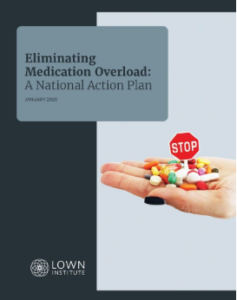
Several years ago, an elderly patient — let’s call her Eve — came to Kaiser Permanente because she was dazed and feeling “out of it” on a regular basis.
Her family chalked it up to old age and eventually contemplated putting her in a nursing home. The problem was, Eve wasn’t experiencing the normal symptoms of old age, nor was she suffering from a medical condition. A slew of tests confirmed that.
After thoroughly reviewing her medical records, her doctors discovered that she was on 15 different medications and determined that the side effects were the likely culprit of her symptoms. After her doctors carefully removed a few of her medications, a process called deprescribing, Eve bounced back and spent the remainder of her life living independently, had a vibrant social life, and maintained a close relationship with her family.
A case like Eve’s is one that rarely gets taught in medical school. It doesn’t grab headlines or command much attention in discussions about improving health care quality. But the reality is Eve’s case is not unique. In the past 10 years, medication-related injuries, known as adverse drug events or ADEs, accounted for 2 million hospitalizations in the older adult population. In 2018 alone, there were 280,000 hospitalizations and 9,000 deaths associated with ADEs. Although there are several reasons why ADEs can occur, polypharmacy — taking multiple medications — puts older adults at much greater risk. Research shows that older adults who take 5 or more medications are 88% more likely to seek outpatient care for an ADE than those who take 1 or 2 medications. With a staggering 40% of older adults taking 5 or more medications per day, it’s safe to say that polypharmacy is something we need to pay attention to.
Kaiser Permanente’s experience
 For the past year, Kaiser Permanente has collaborated with the Lown Institute, a nonprofit organization that sheds light on the harms that can result from polypharmacy. As an advisor to Lown, we’ve had the privilege of sharing our organization’s successes with deprescribing, which has helped inform a pivotal report, Medication Overload: America’s Other Drug Problem, and a new national action plan to address the issue.
For the past year, Kaiser Permanente has collaborated with the Lown Institute, a nonprofit organization that sheds light on the harms that can result from polypharmacy. As an advisor to Lown, we’ve had the privilege of sharing our organization’s successes with deprescribing, which has helped inform a pivotal report, Medication Overload: America’s Other Drug Problem, and a new national action plan to address the issue.
Addressing medication overload in older adults is no easy feat. At Kaiser Permanente, it has taken several years of collaboration and systemic change to care delivery and organizational culture to get where we are. We began our journey in 2016, bringing numerous stakeholders together to acknowledge and address polypharmacy within our system. Raising awareness across the organization was a crucial first step, but to change clinical practice, we knew we had to go further. We began the rigorous and ongoing process of developing up-to-date, evidence-based protocols, which provide the basis to deprescribe safely and have generated buy-in across the organization.
Another key part of our success has been to leverage our integrated system in which pharmacists, clinicians, and other care team members work closely together on patient care, and our electronic health record to identify medication issues and outcomes at both an individual and population level.
As a result of these efforts, we’ve seen significant improvements in health outcomes for our patients. A recent study of our geriatric patients showed that patients who were deprescribed non-steroidal anti-inflammatory drugs (known as NSAIDs) were able to achieve the same amount of pain control as patients who take a typical regimen of NSAIDs. In addition, we found that the rate of hospitalizations and emergency rooms visits resulting from exacerbated pain was twice as high for patients still taking NSAIDs.
In another study, we found that deprescribing certain antidiabetic medications reduces risk of hypoglycemia (a cause of low blood sugar) and may reduce all-cause mortality (risk of death) while maintaining good management of diabetes.
A national approach to deprescribing
We have also come to discover — as outlined in the Medication Overload report and the national action plan — that changes inside and outside of the 4 walls of the delivery system are necessary to truly address this issue. Knowledge and awareness about polypharmacy needs to be communicated at every touch point: professional and continuing education, clinical guidelines, the point of care delivery, and through broader public awareness campaigns. Our nation must also continue to move toward integrated care and adopting robust electronic health records.
And finally, we must acknowledge and address the pharmaceutical industry’s influence on overprescribing and inappropriate prescribing. Too often patients and providers receive biased information that shrouds evidence on drug safety, efficacy, and drug-drug interactions, while perpetuating a belief that “more is better” when it comes to prescribing.
Although addressing medication overload can feel daunting, there are concrete actions we can take to make headway. With the right efforts and coordination across sectors, outcomes like Eve’s will become the rule, not the exception.

